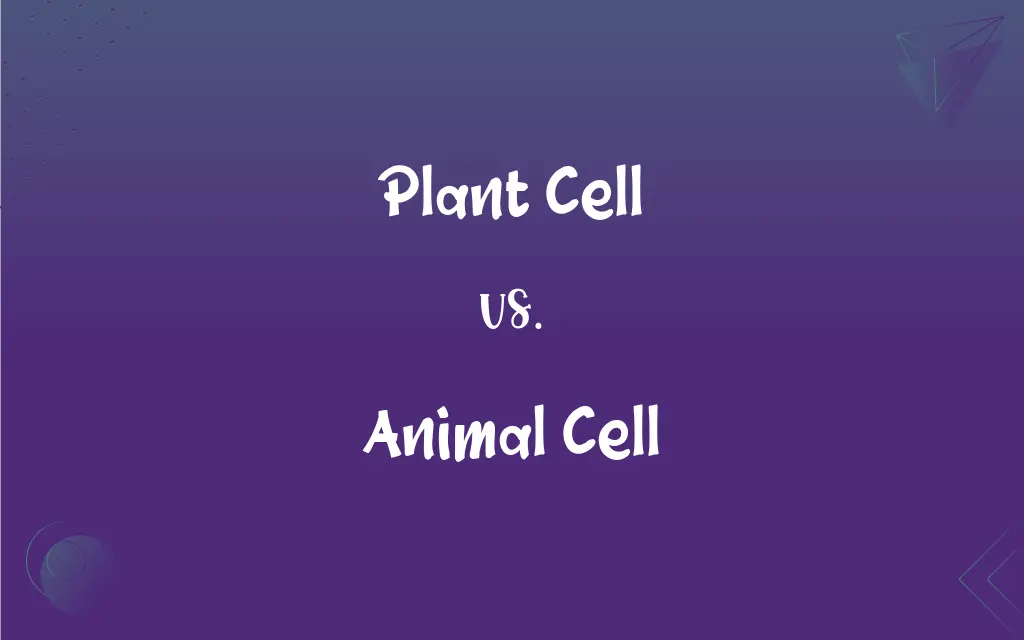Plant Cell vs. Animal Cell: What's the Difference?
Edited by Janet White || By Harlon Moss || Updated on October 4, 2023
Plant cells have a rigid cell wall, chloroplasts, and large central vacuoles. Animal cells lack these structures but possess lysosomes and centrosomes.

Key Differences
Plant cells are the fundamental units that make up the tissues and organs of plants. Animal cells are the basic building blocks of animals. While both are eukaryotic cells, they exhibit several distinct structural differences.
Plant cells are typically rectangular or square-shaped due to a rigid cell wall that surrounds their cell membrane. This cell wall, mainly composed of cellulose, provides structural support. Animal cells, on the other hand, do not have a cell wall, resulting in varied and irregular shapes, primarily maintained by their semi-permeable cell membrane.
One of the most noticeable features of plant cells is the presence of chloroplasts. These organelles contain chlorophyll, which enables photosynthesis, allowing plants to convert light energy into chemical energy. Animal cells do not have chloroplasts and, therefore, cannot perform photosynthesis.
Plant cells contain a large central vacuole that stores nutrients, waste products, and helps maintain turgor pressure. In contrast, animal cells have smaller vacuoles and might possess lysosomes, enzyme-containing organelles responsible for digesting cellular waste.
Both plant and animal cells contain mitochondria, responsible for producing energy. However, only animal cells typically contain centrosomes, structures that play a role in cell division.
ADVERTISEMENT
Comparison Chart
Shape
Typically rectangular due to cell wall.
Varied and irregular.
Cell Wall
Present, made of cellulose.
Absent.
Chloroplasts
Present for photosynthesis.
Absent.
Vacuole Size
Large central vacuole.
Smaller vacuoles.
Lysosomes & Centrosomes
Rarely present in lysosomes; No centrosomes.
Lysosomes are common; Centrosomes present.
ADVERTISEMENT
Plant Cell and Animal Cell Definitions
Plant Cell
The basic structural unit of plants.
The leaf consists of numerous plant cells.
Animal Cell
Eukaryotic cells lacking a cell wall and chloroplasts.
The animal cell has a flexible structure due to the absence of a rigid wall.
Plant Cell
An organism's cellular building block with a capability for photosynthesis.
Plant cells utilize sunlight to produce energy.
Animal Cell
The fundamental unit forming animal tissues and organs.
The muscle tissue comprises numerous animal cells.
Plant Cell
Cells that possess a rigid structure due to cellulose walls.
Water storage in the plant cell occurs in the central vacuole.
Animal Cell
A cell type characterized by lysosomes and centrosomes.
Centrosomes in the animal cell assist in cell division.
Plant Cell
Eukaryotic cells characterized by a cell wall and chloroplasts.
In the plant cell, photosynthesis occurs in the chloroplasts.
Animal Cell
The primary structural and functional unit of animals.
Animal cells require a continuous supply of oxygen for survival.
Plant Cell
A cell that makes up the tissues and organs of plants.
A plant cell's rigid structure protects its internal components.
Animal Cell
Cells that make up the entirety of animal organisms.
Each animal cell works in harmony to ensure the organism's well-being.
FAQs
What defines an animal cell?
It's the foundational unit forming animal tissues and organs.
Do animal cells have a cell wall?
No, animal cells lack a cell wall.
What's the function of chloroplasts in plant cells?
They facilitate photosynthesis by converting light energy to chemical energy.
How do plant cells store nutrients?
They use a large central vacuole.
Do plant cells have a cell wall?
Yes, plant cells have a cell wall made primarily of cellulose.
How do cells produce energy?
Both plant and animal cells use mitochondria for energy production.
Why do plant cells need a rigid structure?
The rigid cell wall provides structural support and protection.
What are lysosomes?
They are enzyme-containing organelles in animal cells that digest waste.
Are lysosomes common in plant cells?
They are rarely present in plant cells.
What is a centrosome's role in animal cells?
It assists in cell division.
Which cell type contains more lysosomes?
Animal cells typically have more lysosomes.
What is a plant cell?
It's the basic structural and functional unit of plants.
Do animal cells have chloroplasts?
No, animal cells lack chloroplasts.
Do animal cells have large central vacuoles like plant cells?
No, animal cells have smaller vacuoles.
Do plant cells contain centrosomes?
Typically, plant cells do not have centrosomes.
What shape are plant cells typically?
They are often rectangular due to the presence of a cell wall.
Do plant cells perform photosynthesis?
Yes, thanks to chloroplasts.
Why are animal cell shapes varied?
They lack a rigid cell wall, resulting in varied shapes.
Can animal cells conduct photosynthesis?
No, they cannot perform photosynthesis.
Are both plant and animal cells eukaryotic?
Yes, both are eukaryotic, meaning they have a nucleus.
About Author
Written by
Harlon MossHarlon is a seasoned quality moderator and accomplished content writer for Difference Wiki. An alumnus of the prestigious University of California, he earned his degree in Computer Science. Leveraging his academic background, Harlon brings a meticulous and informed perspective to his work, ensuring content accuracy and excellence.
Edited by
Janet WhiteJanet White has been an esteemed writer and blogger for Difference Wiki. Holding a Master's degree in Science and Medical Journalism from the prestigious Boston University, she has consistently demonstrated her expertise and passion for her field. When she's not immersed in her work, Janet relishes her time exercising, delving into a good book, and cherishing moments with friends and family.































































